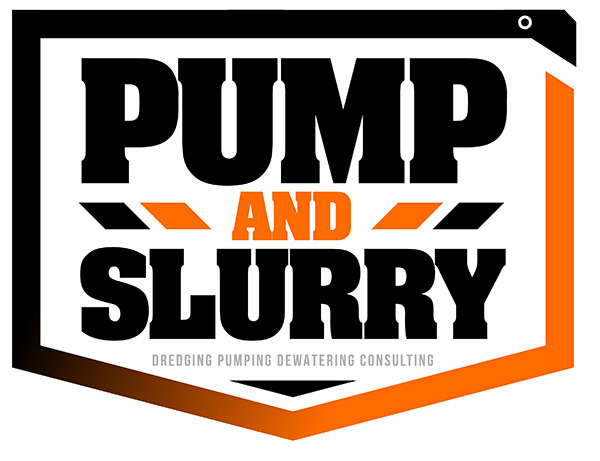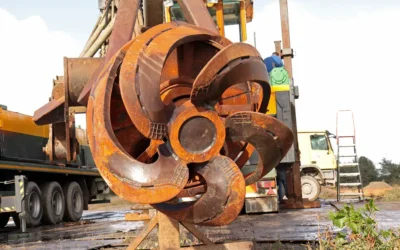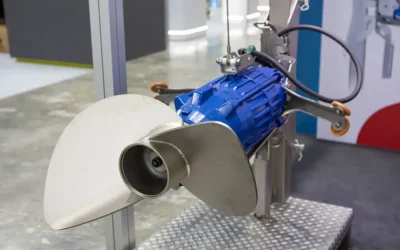Maintaining a pond’s health and longevity requires periodic dredging to remove accumulated sediment, debris, and organic matter. Over time, ponds naturally fill with silt, sludge, and other materials, leading to decreased water depth, poor water quality, and impaired ecological function. To ensure effective pond restoration and sediment removal, selecting the right pond dredging equipment is crucial.
This guide walks you through key considerations—pond size, water depth, sediment type, and budget—to help you choose the most suitable pond dredging equipment for your specific needs. Whether you’re a property owner managing a small pond or a business responsible for a large-scale project, understanding these factors can lead to efficient and cost-effective results. In many cases, using a well-suited pond dredge can significantly improve operational efficiency. Additionally, working with experienced pond dredging companies can further streamline the process, minimize environmental risks, and ensure compliance with local and national regulations.
Why Pond Dredging Is Necessary
Pond dredging is a vital process in managing sediment buildup, maintaining water depth, and preserving aquatic ecosystems. Sediment accumulation occurs naturally due to erosion, the decay of vegetation, and runoff. However, without intervention, this buildup can lead to several issues:
- Reduced storage capacity and water depth
- Oxygen depletion and poor water quality
- Increased risk of algae blooms and eutrophication
- Habitat loss for aquatic life
- Impaired drainage and irrigation systems
The use of appropriate pond dredging equipment allows for efficient sediment removal, restoring the pond’s functionality. For more extensive or technical projects, pond dredging companies provide the expertise, manpower, and equipment necessary to handle the task professionally and responsibly.
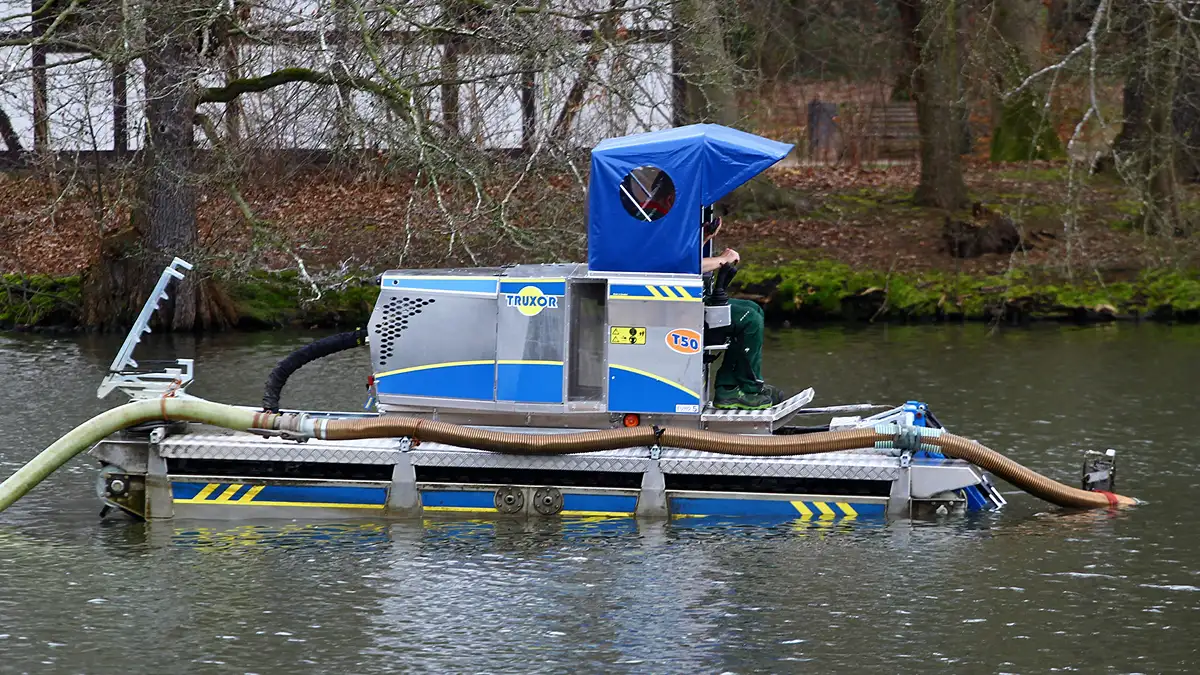
Key Factors to Consider When Choosing Pond Dredging Equipment
Selecting the right pond dredging equipment involves evaluating several critical factors that impact the type and size of the dredge you’ll need. Below are the four primary considerations:
1. Pond Size and Surface Area
One of the first factors to consider is the overall size of your pond. The surface area will influence the scale and power requirements of the pond dredging equipment.
Matching the scale of your pond with the appropriate pond dredging equipment ensures efficient coverage without underperformance or unnecessary expense.
2. Water Depth and Accessibility
Depth is another key aspect when choosing pond dredging equipment. Deeper ponds require dredging systems that can reach and operate effectively at greater depths. Shallow ponds, on the other hand, may only need surface-level sediment removal.
In addition to depth, consider the accessibility of the pond. If the area is surrounded by thick vegetation, has narrow access paths, or includes islands or features within the pond, it may limit your choice of equipment. An amphibious or floating pond dredge can be ideal in these cases, as they provide mobility and flexibility even in challenging environments.
Choosing a pond dredging company that specializes in working with limited-access sites can ensure the job is done without damaging the surrounding landscape or infrastructure.
3. Sediment Type
The type of material you need to dredge is the most critical determinant of equipment choice. Common sediment types include:
- Silt and clay: Soft and easily suspended in water. Hydraulic suction dredges are best suited for handling these materials.
- Sand and gravel: Heavier and more abrasive, requiring durable equipment with higher suction power.
- Organic muck and vegetation: Requires shredding and suction or mechanical removal.
The wrong equipment can result in inefficiencies, equipment damage, or incomplete sediment removal. For instance, using a small pond dredge designed for light silt in a pond filled with dense, compacted clay would be ineffective. Many companies conduct sediment testing to determine the best dredging approach.
4. Project Budget
Budget is a limiting factor for most projects, and the cost of pond dredging equipment can vary significantly. Consider the following options:
- Renting: Ideal for one-time or occasional dredging needs. Lower upfront cost and no maintenance responsibilities.
- Purchasing: Suitable for frequent dredging or large-scale operations. Higher initial cost but more control and long-term value.
- Hiring pond dredging companies: While this may have a higher cost upfront, it includes labor, expertise, and equipment, often saving time and reducing risk.
Budget planning should also account for additional expenses, such as transportation, fuel, sediment disposal, and any required permits or environmental compliance fees.
Types of Pond Dredging Equipment and Their Use Cases
Different pond dredging equipment are designed for specific applications. Understanding each type and its strengths can help you make an informed decision.
1. Mechanical Dredgers
These dredges use buckets, backhoes, or draglines to scoop sediment from the pond floor. They are typically used in dry dredging scenarios, where the pond is drained before dredging begins.
- Pros: Effective for coarse material and heavy debris
- Cons: Requires pond drainage, potential damage to pond structure
Mechanical dredging is often used in construction or restoration projects where precise excavation is needed. If your pond is dry or can be temporarily drained, mechanical systems may be a suitable option.
2. Hydraulic Dredgers
Hydraulic pond dredging equipment uses suction to remove sediment and transport it through pipelines to a discharge site.
- Pros: Minimal disruption to pond structure, works well underwater
- Cons: Limited by sediment type, requires water for operation
Hydraulic dredgers are ideal for removing fine sediment and organic muck while preserving aquatic life. Many pond dredging companies prefer this method for its efficiency and minimal environmental impact.
3. Portable Pond Dredges
Portable systems are compact, easy to deploy, and designed for smaller ponds or locations with limited access.
- Pros: Easy to operate, affordable for DIY pond owners
- Cons: Limited power and reach
These systems are often manually operated and suitable for maintenance dredging rather than major restoration. If you’re looking to clear out light sediment or debris from a small pond, a portable pond dredge may be all you need.
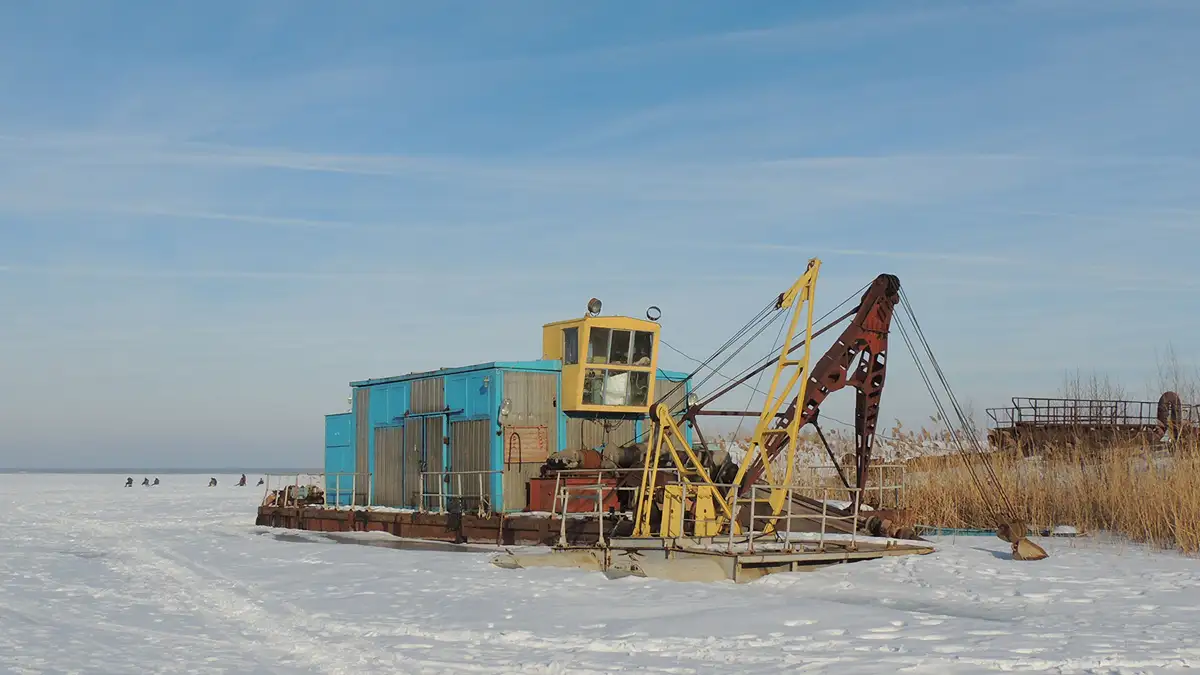
Choosing Between DIY and Professional Pond Dredging Companies
When deciding between handling the project yourself or hiring professionals, consider the following:
DIY Approach
- Pros: Cost-effective, flexible schedule, good for small jobs
- Cons: Steep learning curve, limited by equipment capabilities, risk of incomplete dredging
If you have prior experience, the right pond dredging equipment, and a simple project, DIY dredging can be a viable option.
Hiring Pond Dredging Companies
- Pros: Access to specialized equipment, trained crews, and environmental expertise
- Cons: Higher initial cost, dependent on contractor availability
Professional pond dredging companies offer the full package—from site assessment and equipment selection to sediment disposal and compliance with local regulations. They also reduce the risks of damage, ensure thorough dredging, and provide long-term solutions.
For larger, deeper, or environmentally sensitive ponds, it is highly recommended to work with pond dredging companies.
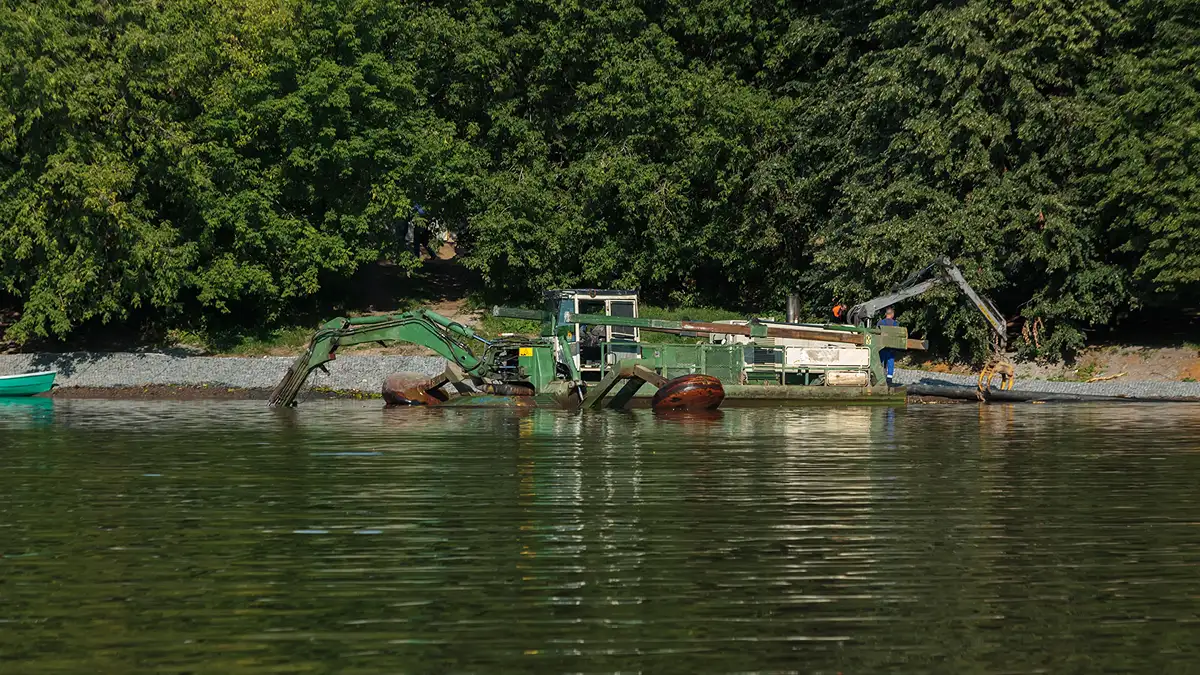
Environmental and Legal Considerations
Pond dredging isn’t merely a mechanical process of removing sediment. It carries significant environmental and legal responsibilities that must be addressed before any work begins. Choosing the right pond dredging equipment is just one part of the equation—understanding the broader impact of dredging on ecosystems, water quality, and regulatory compliance is equally important.
1. Permitting and Regulatory Compliance
In many regions, dredging a pond requires prior approval or permits from local, state, or even federal agencies. These permits are designed to protect aquatic habitats, prevent pollution, and ensure sustainable practices. Regulatory bodies often assess the potential impact of dredging activities on fish populations, wetlands, and water quality.
Obtaining permits can be a complex process involving environmental assessments, project documentation, and compliance with zoning laws. This is where pond dredging companies prove invaluable. Their experience with regulatory procedures and local laws makes it easier to secure the necessary approvals without delays or rejections. They often coordinate directly with environmental authorities to ensure that the use of pond dredging equipment aligns with legal requirements.
Failing to secure proper permits before using a pond dredge can result in legal penalties, including hefty fines or orders to halt the project. Therefore, it’s essential to factor in permit acquisition when budgeting and scheduling your dredging operations.
2. Environmentally Responsible Sediment Disposal
Pond dredging companies often include sediment testing as part of their services. This helps determine the appropriate disposal method based on the type of material removed by the pond dredging equipment. They also ensure that transportation and disposal are handled in compliance with environmental regulations, mitigating risk for the pond owner.
3. Erosion, Runoff, and Ecosystem Impact
Improper use of pond dredging equipment can disturb the natural balance of a pond’s ecosystem. For instance, over-dredging or aggressive sediment removal can destroy aquatic vegetation, disrupt fish habitats, and cause sudden changes in water chemistry.
Using the correct type of pond dredge—one that is appropriate for the pond’s size, depth, and sediment type—helps minimize these risks. Portable dredges with lower disturbance levels are ideal for sensitive areas. Professional pond dredging companies carefully assess site conditions and implement erosion control measures such as silt curtains, buffer zones, and staged dredging techniques.
4. Best Practices and Long-Term Responsibility
Dredging a pond is not a one-time task, but rather a part of long-term pond management. From an environmental standpoint, best practices include minimal disturbance, proper sediment disposal, regular water quality monitoring, and sustainable shoreline maintenance. Selecting eco-friendly pond dredging equipment and working with knowledgeable pond dredging companies ensures that the pond remains a healthy and productive ecosystem over time.
In summary, legal and environmental considerations should never be an afterthought in dredging projects. From permitting to sediment disposal and erosion control, every step demands careful planning and adherence to best practices. By utilizing the right pond dredging equipment and collaborating with reputable pond dredging companies, you can achieve your dredging goals while maintaining environmental integrity and adhering to legal standards.
Tips for Maintaining Your Pond Post-Dredging
After completing a dredging project using the appropriate pond dredging equipment, the next step is to implement a long-term maintenance plan. Post-dredging maintenance is essential to preserve the restored pond conditions, prolong the time between dredging cycles, and prevent the rapid return of sediment buildup. Whether the job was handled with a personal pond dredge or through professional pond dredging companies, the following practices can help ensure the longevity of your efforts.
1. Control Runoff and Erosion
One of the primary sources of sediment in ponds is runoff from surrounding land. When rainwater flows across bare soil or agricultural fields, it carries soil particles and organic material into the pond. Over time, this results in sediment accumulation and a decline in water quality.
To combat this, plant buffer vegetation—such as grasses, shrubs, or native plants—around the pond perimeter. These plants act as a natural filter, capturing sediment before it enters the water. In areas with steep slopes near the pond, implement erosion control strategies like mulch cover, terracing, or geotextile fabric to reduce soil displacement.
By reducing sediment inflow, you help preserve the effectiveness of your pond dredging equipment and extend the pond’s functional life. This preventive step is often recommended by experienced pond dredging companies during post-project consultations.
2. Conduct Regular Inspections
Even with proper runoff control, it’s important to monitor the pond regularly. Perform visual checks for signs of sediment accumulation, such as shallower depth in certain areas, murky or brownish water, or an increase in aquatic vegetation.
Early identification of these issues allows for targeted action before a full-scale dredging effort is needed. A portable pond dredge may be sufficient for touch-up work in isolated areas. If more substantial sediment buildup is observed, consulting with pond dredging companies can provide a quick assessment and prevent the issue from escalating.
Scheduling inspections at least twice a year—preferably after heavy rainfall seasons—can help you stay on top of sediment issues and avoid costly future interventions.
3. Install and Maintain Aeration Systems
Aeration systems play a critical role in maintaining a healthy aquatic environment. By circulating water and introducing oxygen, pond aerators help accelerate the decomposition of organic matter, which is a major contributor to sediment buildup.
Oxygen-rich water supports beneficial bacteria that break down decaying plant material, fish waste, and other organic debris. This microbial activity reduces the formation of sludge at the bottom of the pond, minimizing the workload for your pond dredging equipment in future maintenance cycles.
For ponds that were recently cleaned using a pond dredge, installing an aeration system is a smart investment to maintain clarity, water quality, and balanced biological activity.
4. Schedule Routine Maintenance Services
If you own pond dredging equipment, follow the manufacturer’s recommended maintenance schedule to ensure your dredge continues to perform efficiently. This includes cleaning filters, inspecting suction hoses, checking motor performance, and replacing worn components as needed. Regular equipment maintenance not only extends the life of your pond dredge but also guarantees that you’re prepared for any minor dredging tasks that arise.
For pond owners who do not own their equipment, establishing a service contract with professional pond dredging companies is a smart move. These companies can perform periodic cleanings, remove problem sediment areas, and assess the overall health of the pond. Scheduled maintenance visits by experts ensure consistent water quality and reduce the risk of needing another large-scale dredging operation.
Putting It All Together: Your Pond Dredging Strategy
Choosing the right pond dredging equipment is essential for maintaining the health, function, and appearance of your pond. By considering factors such as pond size, depth, sediment type, and budget, you can select the most suitable dredging solution for your specific needs.
For small-scale or simple projects, a portable pond dredge may be sufficient. For more complex situations, especially those involving heavy sediment, deep water, or environmental sensitivity, working with experienced pond dredging companies can save time, reduce risk, and ensure compliance with local regulations.
With the right approach, tools, and knowledge, you can restore your pond to optimal condition, improving water quality, increasing depth, and supporting aquatic life for years to come.
Need help choosing the right pond dredging solution? Speak with our team to get started.




